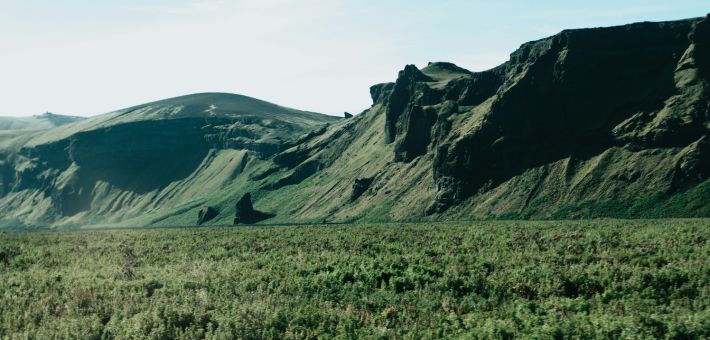Commentary on Jeremiah 17:5-10
Jeremiah 17:5–10 is strongly reminiscent of Hebrew wisdom literature, written in poetry and utilizing comparisons to express general truths. As in Psalms and Proverbs, poetic phrases are written in parallel lines, expressing a given point in multiple ways. Those who “trust in mortals” are also characterized as those who “make mere flesh their strength” and those whose “hearts turn away from the LORD” (17:5). People’s “ways” are “the fruit of their doings” (17:10). This synonymous parallelism imparts to the poem a rhythm and beauty.
Like other Hebrew poetry, this passage also communicates by employing metaphor. Here, those who trust in God are compared to a well-watered and deeply rooted tree, while those who depend upon human powers are like a shrub languishing in a dry desert. A similar comparison is made in Psalm 1, in which those who choose the path of life are “trees planted by streams of water” (verse 3) and the wicked are “chaff that the wind blows away” (verse 4).
Despite the similarities between the two poems, however, Jeremiah packs a much harder punch than Psalm 1’s general wisdom for living. When read in the context of the chapter and the book as a whole, Jeremiah 17:5–10 undergirds the book’s repeated insistence that Judah and Jerusalem must submit to the invading Babylonian armies and abandon any claims to national sovereignty. The Babylonian military incursion of the sixth century BCE is God’s doing, it claims, the justified punishment for the nation’s failures.
In Jeremiah 17:4, God declares, “by your own act you shall lose the heritage that I gave you.” This claim is amplified later in the book: “I myself will fight against you with outstretched hand and mighty arm, in anger, in fury, and in great wrath. And I will strike down the inhabitants of this city, both human beings and animals; they shall die of a great pestilence” (23:5-6).
The opening verses of Jeremiah 17 echo the book’s frequent explanation of why this punishment has been decreed. In scandalous, often even misogynistic language, the prophet accuses Judah and Jerusalem of unfaithfulness (verses 2–3; also see 2:20–25; 7:30–34; 8:4–12). The verses that follow the lectionary selection underscore the book’s criticism of those who rely on their wealth and religious heritage while failing to honor God (17:11, 19–27; see also Jeremiah 7; 9:23).
Anchoring this message, the wisdom poem of Jeremiah 17:5–10 paradoxically declares that letting go of traditional understandings of security and safety is the only ground in which God’s people can flourish. This message is reiterated powerfully in Jeremiah 29, when the prophet insists that those who were captured during the first Babylonian invasion of the city should not fight to return but rather settle down, have children, marry those children to others, and pave the way for grandchildren to be born outside of Jerusalem. They should make a life where they are and pray for the land on which they are now settled, the place forced upon them against their will. Their welfare would rely on Babylon’s welfare, not the welfare of the place they once called home.
The plant metaphors used in this poem clearly convey the book’s bold (even scandalous) claim about the relative non-importance of human institutions. Strong armies, secure borders, national independence, sustainable religious bodies—Jeremiah challenges them all as ultimate goals. Such standards by which humans judge success are as shallow as the roots of a shrub. Like the other frequent natural imagery in the Prophets (people as grass and sheep; God as rock and lion), these images are a powerful vehicle for communicating a larger message.
In our current ecological context, however, perhaps the tree and the shrub themselves deserve our attention. Rather than treating nonhuman life as existing solely for our benefit (a supreme act of anthropocentrism and exploitation), what happens when we read with—and for—the plants in this passage?
As rampant deforestation turns more spaces into desert and water sources diminish on an increasingly hot and dry planet, Jeremiah’s description of parched, salty land will become an increasingly common reality. The plants struggling in these environments will be visual reminders of the greed that has treated Earth simply as a repository of resources to be exploited; they will testify to human failure.
If in the coming decades we are fortunate enough to behold well-watered and sturdy trees, they will testify to our repentance, moving beyond the simple models of “creation care” and “environmental stewardship” to face squarely the extent of Earth’s crisis and the human dynamics that fuel it. Just as Jeremiah once asked of his audience, we will have chosen to honor Earth and its Creator rather than our own interests.
The Prophets used such literary metaphors to help their audiences “see” the realities before them. To help modern audiences grasp the extent of Earth’s crisis, preachers have at their disposal not only words but also a powerful visual resource: photographic images of contemporary environmental devastation. Photography documents reality in ways that paintings and graphic images cannot, taking less than 13 milliseconds for the eye to process—faster than a blink. Displaying high-quality photos of contemporary drought, deforestation, and wildfire (with proper copyright permissions, of course) as Jeremiah 33 is read and interpreted can viscerally remind us of just how deeply the fate of nonhuman life is intertwined with our own.
For Further Reading
Beal, Timothy K. 2022. When Time is Short: Finding our Way in the Anthropocene. Boston: Beacon.
Marlow, Hilary. 2009. Biblical Prophets and Contemporary Enviornmental Ethics: Re-reading Amos, Hosea, and First Isaiah. Oxford: Oxford University Press.
Sharp, Carolyn J. 2021. Jeremiah 26-52. International Exegetical Commentary on the Old Testament. Stuttgart: Kohlhammer.
For photographic resources, consider search sites such as Shutterstock, Pixabay, or simply adding a filter such as “Creative Commons licenses” to an internet search.


February 16, 2025